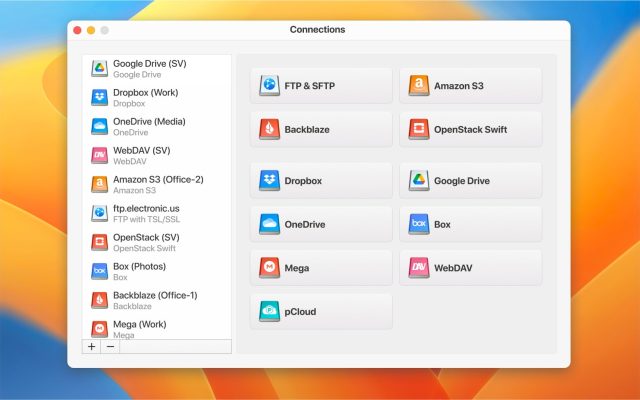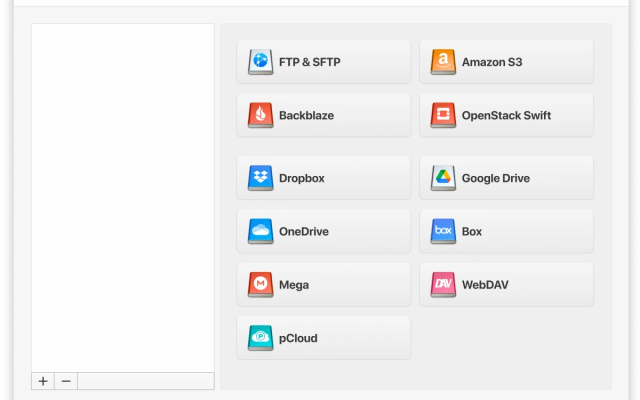Before jumping to the answers for “What is Amazon S3?” how it works, and how you can use it for everyday tasks, we need to tackle the matter of its interface. Since the Simple Storage Service doesn’t use the standard Files and Folders for organization, it can feel rather difficult to navigate.
However, CloudMounter is the tool you can use to replace the standard Amazon S3 client and interface so that everything feels smooth and familiar. CloudMounter allows you to choose which AWS S3 buckets to mount on your computer as a disk so you can have faster access to your data.
I have a team of 3 full-time employees and 5 part-time employees. We've never had an organization scheme applied to our shared drive and we've been using someone's personal google drive account. Someone recommended that we move the files to AWS S3. What are the pros and cons? How easy is it to setup?— from Reddit
What is S3, and What are its Main Functions?
The Simple Storage Service from Amazon is a cloud-based solution for data storage. Amazon’s aim with the S3 was to deliver to its users the ability to store data over long periods of time and gain fast access to the said content. In other words, even if you store large files that you didn’t use for a long period of time, you will be able to access it like it was recently uploaded and often used.
The functions offered by Amazon S3 include:
- Appending metadata tags to objects;
- Moving various data across the different storage classes;
- Configuring access and sharing settings to safeguard against unauthorized users;
- Running big data analytics;
- Monitoring the activity trends and storage usage in real-time.
For all types of users, all these functions sound very good on paper. However, those of a skeptical nature will want to know the technology behind Amazon’s S3. If you feel this sentence is about you, we’ll cover this aspect in the next paragraph.
What’s the Technology Behind Amazon S3?
If you are looking for walkthroughs such as a Simple Storage network guide, we have other articles on the website that cover that part as well. Instead, this section is devoted to taking a closer look at the technology used by Amazon to run S3 and keep meeting all the expectations. If this is the first time you’re reading about the Simple Storage Service, you should know it doesn’t use the standard approach to data storage – files, folders, and directories to include them all. Instead, they use objects that are placed within buckets, which are stored in various storage classes.
Storage Management and Monitoring
From a storage management point of view, S3’s flat, non-hierarchical structure allows users to organize data more conveniently for their team and business. Each S3 object can be appended with a 10 key-value pair so easily keep track of the data. Furthermore, the S3 Inventory allows you to create reports for all stored objects. You can either request a report for the objects within a specific S3 bucket, with a given prefix, or metadata/encryption status. Even more than that, Amazon’s Simple Storage solution enables you to configure reports weekly or daily.
If we’re talking about monitoring, the technologies used here are also innovative and focused on efficiency and simplicity. You can apply a tag to each AWS S3 bucket to allocate and keep track of costs across different business dimensions. Using services like the AWS Cost Allocations Reports or the Amazon CloudWatch, you can always be updated on your resource’s health, so you always know what’s the next move.
S3 Storage Classes
Since we’ve mentioned that Amazon offers users multiple classes for data storage, let’s quickly list them here, so you know the depth of the services offered by S3. So, using the Amazon S3 cloud you will be able to store your objects in buckets placed in:
- S3 Standard;
- S3 Intelligent-Tiering;
- S3 Standard-Infrequent Access;
- S3 One Zone-Infrequent Access;
- Amazon S3 Glacier;
- Amazon S3 Glacier Deep Archive;
- S3 Outposts.
Each of these classes plays an important part in making sure your data is instantly available upon access, no matter the size or when it was uploaded into the cloud. For a further analysis of storage classes, check out this resource.
Disadvantages of Amazon S3
- Complex pricing structure. Amazon S3 has a complex pricing model that includes fees for storage, data, queries, and additional features. Understanding and predicting costs can be challenging.
- Amazon’s S3 limits. One of the main downsides of Amazon S3 is that AWS allocates resources based on location, meaning that some regions may have fewer resources available. It can also be difficult to keep track of resources consumed, although additional resources can be requested if needed. Additionally, new users face restrictions on the number of resources they can access.
- Data management complexity. Data management in S3 can be a challenge, especially for large-scale deployments. Organizing, tagging, and maintaining access control over vast amounts of data requires meticulous planning.
- Network latency issues. Although the S3 is highly reliable, Amazon S3 performance can be affected by network latency when transferring data over the Internet. This can result in slower data retrieval.
What are the Options and Pricing for Using the Simple Storage Service?
Before jumping into pricing and the multiple options you have to configure S3 so that it delivers the best results for your company, let’s get the part about servers and available clients out of the way.
Since the Amazon S3 cloud storage solution is a global service, it has servers worldwide to ensure the same connectivity speed no matter the location. Therefore, no matter if you use the Frankfurt, Seoul, Ohio, Mumbai, Central, London, or Beijing servers, you can rely on the same excellent services. Also, Amazon offers a web and desktop client to interact with the S3 and get the job done. Both go through the Amazon S3 console and you get a lot of functionality out of these clients no matter if you go for the desktop app or the website. However, if you’re not familiar with the console, navigation may seem difficult. We’re going to thoroughly cover the alternative for the S3 native clients in a future section. For now, let’s return to the AWS S3 pricing.
You can rest assured knowing that you only pay for what you use. With S3 there is no minimum fee and the final price is given by four major components:
- Storage;
- Request and data retrieval;
- Data transfer and acceleration;
- Data management.
If you want to try it for free, the AWS Free Tier gives you free access to Amazon S3 where you get 5GB of storage for the S3 Standard class and other perks like 20,000 GET requests, 2,000 POST, PUT, COPY, or LIST requests, and 15 GB of Data Transfer each month. Afterward, you can configure Amazon’s S3 for your company’s exact needs and get the final price using the AWS Pricing Calculator.
Other Providers Relying on the S3 Technology
As is often the case, Amazon did not keep the technology behind S3 to themselves. Aiming to improve the way cloud storage works, they shared it and incorporated it with other third-party services. Here are the most popular such providers:
- Wasabi – relying on S3 technology, this cloud-storage solution presents itself as a cost-effective, revolutionary, and high-performance product. The goal is to make saving data affordable, simple, fast, and secure.
- Min.io – another service that uses Amazon’s technology with the aim to revolutionize the way you save and access big data. This app provides performance and scalability in a hybrid cloud environment designed to deliver top results to entrepreneurs looking for clever solutions.
- Cloudian HyperStore – combining the traditional data storage with S3 compatibility, HyperStore offers users the possibility to deploy nodes wherever storage capacity is needed. Afterward, scaling becomes seamless and users get to choose between HDD-based or all-flash platforms.
- Scality – with a wide range of products designed to work excellently with the S3 storage system, Scality is another provider worth mentioning. Depending on your needs, you can go for the Scality Connect for Azure Blob Storage, Zenko Multi-Cloud Data Controller, or the Zenko Cloudserver.
CloudMounter - the all-in-one solution for all S3 Cloud Storage Providers
We’ve promised to go back to the matter of using the Amazon S3 and other third-party providers through a single app that makes navigation a lot easier and brings everything together. CloudMounter is the solution that enables you to mount Amazon S3 as a network drive and organize data with ease. You won’t need to go through the S3 documentation to get the job done, just use CloudMounter and manage all your data directly on Mac.

The list of features includes facile bucket selection and mounting so you can access it with Finder or Explorer, support for all the S3 regions, and compatibility with other S3 cloud services. Easily switch from S3, Wasabi, Min.io, HyperStore, and many more for a complete experience. Instead of using the native client for each of these storage solutions, CloudMounter gives you access to all of them simply by mounting and unmounting the ones you need. And the list doesn’t end here, you can also connect any FTP or SFTP client using CloudMounter. Dropbox, OneDrive, OpenStack, WebDAV, MEGA, Backblaze B2, you name it.
You will transform your Mac into a hub for all the services to make sure all your data is properly organized. And, as a bonus, you also get an added encryption for all the files you access with this app, as well as Keychain support.
Final Thoughts on Amazon’s S3
Now that we’ve cleared the air on what does S3 stand for and how this cloud storage solution works to deliver top results, it’s time to draw some conclusions as well. First of all, it comes with a different approach than what was proposed by storage solutions before. Even though this makes it a bit more complicated at first, it’s worth taking the time to understand the unlimited opportunities that come with AWS S3. Also, if you use it through CloudMounter, everything will seem a lot more familiar, and organizing your data becomes a lot simpler.
Combining the two solutions, you get the best of both worlds – the revolutionary approach for data storage provided by S3 and the ease of access, increased security, and flexibility brought by CloudMounter.
Popular Articles
Frequently Asked Questions
Indeed, Amazon S3 checks all the boxes to make it a universal service. It is widely available and can provide a wide range of services to solve various storage-related issues and not just that. Furthermore, the free version of S3 is another reason why this service can be deemed universal.
The innovation about the S3 technology comes from the way the data is organized within the system. Instead of going for a hierarchic approach, S3 uses a flat system to store, transfer, and access data. Buckets replace the traditional folders and files are referred to as objects.
There are no limitations when it comes to the type of data that can be stored in Amazon S3. Photos, audio, video, ebooks, software, executables, and pretty much anything you can think of. Amazon S3’s versatility is impressive as there are no restrictions to what you can store on it.
On its own, the AWS S3 is not a file system. It’s much more than that since it provides cloud-storage solutions with a multitude of management, monitoring, and security add-ons. However, if you mount it with a tool such as CloudMounter, you can transform it into a file system. Meaning that you can easily manage the stored data and use your Mac as the platform to do so.
While it isn’t branded as a database, Amazon’s S3 is effectively a NoSQL database. A NoSQL database is the mechanism used to store and retrieve data without going for tabular relations that are normally used in databases. So, while not acting like a standard database, S3 shares lots of traits to NoSQL databases.


